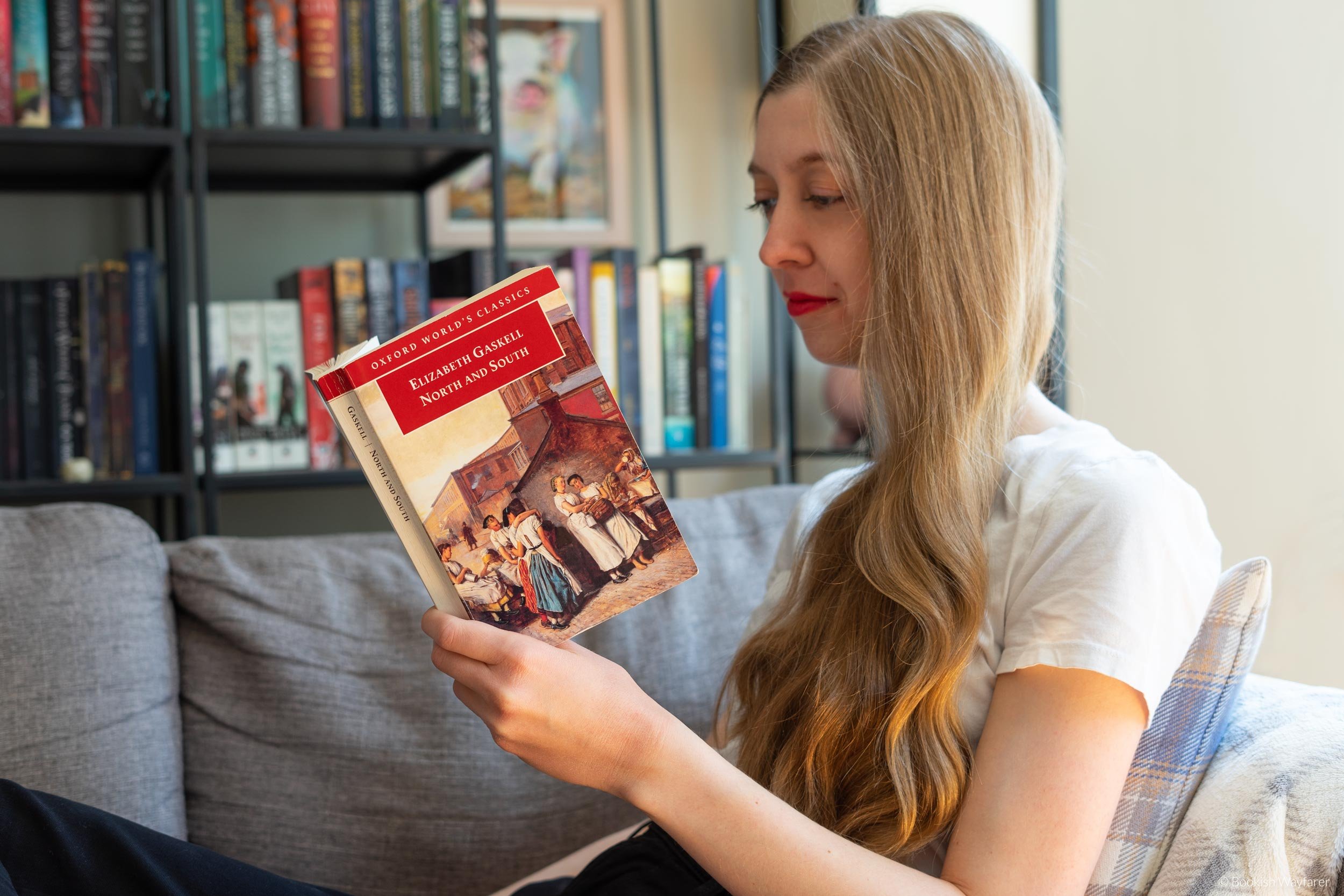Review: North and South by Elizabeth Gaskell
“You look as if you thought it tainted you to be loved by me. You cannot avoid it. Nay, I, if I would, cannot cleanse you from it. But I would not, if I could. I have never loved any woman before: my life has been too busy, my thoughts too much absorbed with other things. Now I love, and will love. But do not be afraid of too much expression on my part.”
Some links in this post are affiliate links, meaning I will earn a commission (at no extra cost to you) if you click through and make a purchase. For more info, please see my disclaimer.
The Basics
Title: North and South
Author: Elizabeth Gaskell
Published: 1998 (originally published 1854)
Publisher: Oxford University Press
Pages: 436
Format: Paperback
Genres: Fiction — Classics, Victorian literature, Romance
Book Synopsis
After her father suffers a crisis of conscience and leaves his post as pastor to a sleepy village in the south of England, Margaret Hale and her parents move north to the industrial city of Milton. There, her father begins to tutor John Thornton, one of the local mill owners. Sympathetic toward the mill workers and their fight for higher wages, she initially detests him and the class he represents, but as she comes to spend more time with Mr. Thornton, she begins to wonder if she might have misjudged him.
My Review & Overall Thoughts
TLDR: A must-read classic.
Warning: Spoilers ahead
I have lost track of the number of times that I have read North and South. It is a book that I never tire of reading, for each time that I read it, I walk away having picked up on or learned something new. It is a layered, multifaceted story that speaks to not only the cultural and political landscape of the mid-19th century but also the attitudes and experiences of the people living during that industrial age. Those attributes alone would be enough to merit North and South distinction, but the novel’s noteworthiness extends beyond that. Namely, it introduces us to two of British literature’s greatest characters, Margaret Hale and John Thornton. As with Elizabeth Bennet and Mr. Darcy before them, Margaret and Mr. Thornton are remarkable on an individual level, but together, they are something else entirely.
They begin as quasi-enemies, with Margaret disdaining Mr. Thornton for his profession. She views manufacturers as disreputable tradesmen who profit off the toil of others. He, on the other hand, regards Margaret with not scorn but rather intrigue from the onset of their acquaintance. Gradually, over the course of the novel, Margaret’s attitude toward Mr. Thornton begins to shift, becoming more positive. The change is so gradual that it is all but imperceptible to her; it is not until his regard for her is threatened that she realizes the true nature of her feelings for him. It is a slow-burn romance in the truest sense, which makes the outcome of their relationship all the more satisfying.
Their relationship is also quite sexually charged – well, at least by Victorian standards. The two have physical contact, the most notable of which being their embrace in chapter 22. Margaret throws her arms around Mr. Thornton in an attempt to shield him from any violence from the assembled mob, and when she later sustains a blow to the head from a rock thrown by one of the gathered workers, he momentarily “encircles” her with one of his arms. This scene and Mr. Thornton’s subsequent recollections of it are laced with sexual undertones; for a novel of its time, it is steamy stuff. And then, there is the ending, which features a not-so-subtle allusion to them kissing. Their romance is as passionate and sexually tense as any featured in a modern-day novel; you simply have to read in between the lines.
Another noteworthy aspect of Margaret and Mr. Thornton’s relationship is the power dynamic between them. Throughout the bulk of the story, Mr. Thornton possesses the financial upper hand. He is wealthy, and Margaret and her parents, while not impoverished, are not prosperous either. Then, near the end of the book, their situations reverse, and Margaret becomes the wealthier of the pair. When the two decide to marry, it is Mr. Thornton, not Margaret, who stands to benefit the most from the match. So many romances feature a well-off man who lifts a woman financially upon their marriage that it is refreshing to see this feminist spin.
Margaret’s superior wealth is not the only feminist aspect of this book. Indeed, throughout the book, her character is a vehicle for feminist ideas and social critiques. Margaret, for instance, scoffs at all of the pomp and circumstance surrounding a marriage, and when she sees Captain Lennox fussing over Edith’s appearance with the aim of showing her off to his friends, she becomes inwardly irate. She also craves independence, detesting being told what to do, and she does not shy away from voicing her opinion. Her gumption and forward-thinking ways are in stark contrast to other female characters, such as Edith and Fanny, who seemingly embrace the feminine ideals of the day and are much meeker in spirit.
North and South speaks to other cultural and societal issues beyond gender roles, such as class discord. The conflict between mill owners and their employees is a central focus of the book, with Nicholas Higgins and Mr. Thornton serving as figureheads for the two sides. The novel also explores the working and living conditions of the mill workers; it lays bare their hardships and daily struggles. Through such descriptions of day-to-day life, as well as the environment at large, Gaskell brings the time period to life. You can all but see the smoke-obscured skies and lint-filled carding rooms of the mills.
Lastly, I just want to take a moment to express how much I love the ending. It is the perfect conclusion to the story, and every time I finish North and South, it is with a smile on my face.
The not so good
The passage of time is not always well conveyed in North and South. For instance, toward the end of the book, there is a reference to Margaret having been in Milton for two years. When I read that, I was shocked, as I had not realized that so much time had passed in the story.
There is also some inconsistency with regard to names. Namely (no pun intended), Edith’s husband is sometimes referred to as Cosmo and other times as Sholto. Granted, he is a fairly minor character, so the lack of clarity around his name does not detract much, if at all, from the overall plot.
My final critique is not so much a critique as a heads-up. North and South is over 160 years old, so it accordingly features antiquated language. I would recommend having a dictionary (or your phone) handy while reading it – you’ll need it (I certainly did).
Overall
North and South is an underrated classic. It sheds light on the social and cultural issues of England during its Industrial Age while simultaneously crafting unforgettable characters and a timeless romance.
Have you read North and South? If so, let me know what you thought of it in the comments section below!
-Julia
P.S. If you enjoyed this post, please consider supporting me on Buy Me a Coffee.



